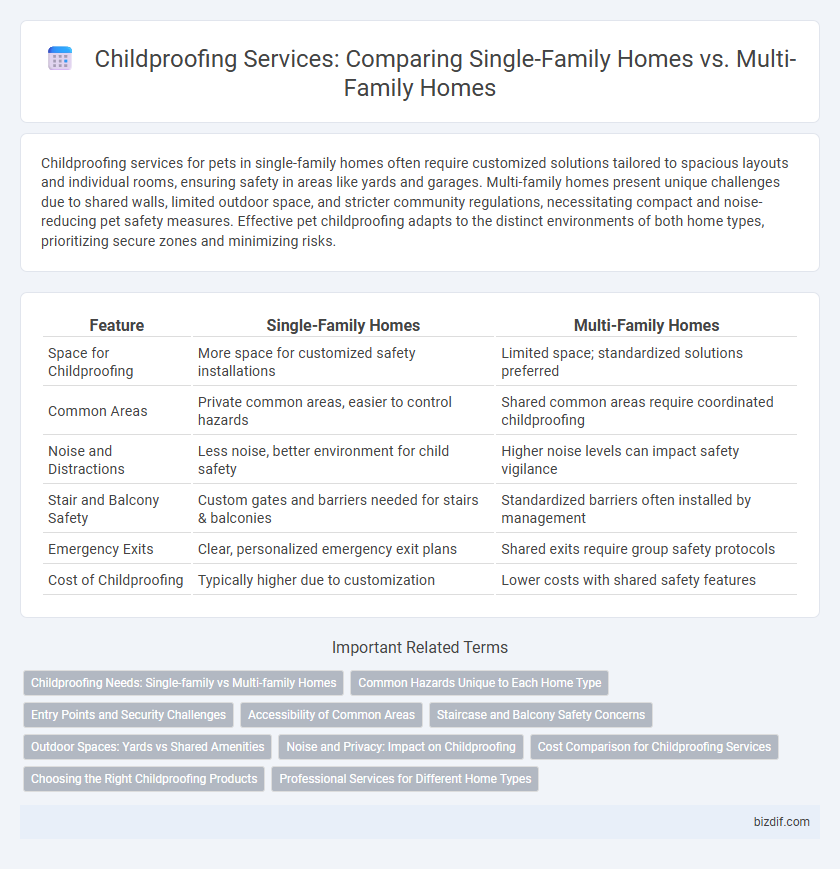Childproofing services for pets in single-family homes often require customized solutions tailored to spacious layouts and individual rooms, ensuring safety in areas like yards and garages. Multi-family homes present unique challenges due to shared walls, limited outdoor space, and stricter community regulations, necessitating compact and noise-reducing pet safety measures. Effective pet childproofing adapts to the distinct environments of both home types, prioritizing secure zones and minimizing risks.
Table of Comparison
| Feature | Single-Family Homes | Multi-Family Homes |
|---|---|---|
| Space for Childproofing | More space for customized safety installations | Limited space; standardized solutions preferred |
| Common Areas | Private common areas, easier to control hazards | Shared common areas require coordinated childproofing |
| Noise and Distractions | Less noise, better environment for child safety | Higher noise levels can impact safety vigilance |
| Stair and Balcony Safety | Custom gates and barriers needed for stairs & balconies | Standardized barriers often installed by management |
| Emergency Exits | Clear, personalized emergency exit plans | Shared exits require group safety protocols |
| Cost of Childproofing | Typically higher due to customization | Lower costs with shared safety features |
Childproofing Needs: Single-family vs Multi-family Homes
Single-family homes require comprehensive childproofing tailored to varied indoor and outdoor spaces, including staircases, pools, and garden areas. Multi-family homes often demand more standardized safety measures, emphasizing secure entry points, shared play areas, and noise control to protect children in close proximity to neighbors. Both settings benefit from customized childproofing solutions to address unique structural and communal hazards.
Common Hazards Unique to Each Home Type
Single-family homes often present hazards such as unsecured staircases, accessible swimming pools, and isolated electrical outlets that require specialized childproofing measures. Multi-family homes commonly face risks including shared entry points, crowded stairwells, and limited outdoor play areas, necessitating tailored safety solutions like reinforced door locks and communal area monitoring. Understanding these unique hazard profiles is essential for effective childproofing strategies in each home type.
Entry Points and Security Challenges
Single-family homes often have multiple entry points including front doors, back doors, and garage access, increasing the need for comprehensive childproofing measures such as secure locks and alarm systems. Multi-family homes typically feature shared entrances and controlled access, presenting unique security challenges like monitoring public corridors and preventing unauthorized access to individual units. Effective childproofing in both settings demands tailored strategies to address the specific vulnerabilities of each entry point and communal area.
Accessibility of Common Areas
In single-family homes, childproofing focuses primarily on internal rooms and private spaces, ensuring doors, windows, and staircases are secure for children. Multi-family homes present unique challenges with common areas such as shared hallways, laundry rooms, and playgrounds, requiring extra attention to access control and hazard prevention to protect children from external risks. Effective childproofing in multi-family residences demands coordinated safety measures across communal spaces to maintain accessibility while minimizing potential dangers.
Staircase and Balcony Safety Concerns
Staircase and balcony safety in single-family homes require customized childproofing solutions such as secure gates and railing guards designed to prevent falls. Multi-family homes often pose additional challenges including shared stairways and balconies, which may lack consistent safety measures and require coordinated childproofing efforts among residents. Proper installation of barriers and safety nets minimizes the risk of injuries related to open railings and uneven stair spacing in both housing types.
Outdoor Spaces: Yards vs Shared Amenities
Single-family homes typically feature private yards, allowing for customized childproofing such as secure fencing and gated play areas that ensure a safe outdoor environment for children. Multi-family homes often provide shared amenities like playgrounds and communal gardens, requiring collaborative safety measures and regular maintenance to prevent hazards. Effective outdoor childproofing in both settings prioritizes secure boundaries, safe surfaces, and hazard-free play equipment tailored to the specific environment.
Noise and Privacy: Impact on Childproofing
Noise levels in multi-family homes can affect a child's sleep and concentration, requiring soundproofing solutions not typically necessary in single-family homes. Privacy concerns are heightened in multi-family units, necessitating secure locks and window guards to prevent unauthorized access. Single-family homes often allow more extensive childproofing modifications due to greater space and fewer shared walls.
Cost Comparison for Childproofing Services
Childproofing services for single-family homes typically incur higher costs due to larger square footage and more entry points requiring safety modifications. Multi-family homes often benefit from shared walls and standardized layouts, which can reduce material and labor expenses, making childproofing more budget-friendly. Pricing for both depends on specific safety features installed, such as secured stair gates, outlet covers, and cabinet locks tailored to the home's size and complexity.
Choosing the Right Childproofing Products
Selecting childproofing products for single-family homes requires focusing on securing entryways, staircases, and individual room hazards unique to larger, spread-out spaces. Multi-family homes often need compact, easily installable solutions that accommodate shared walls and limited outdoor areas while ensuring compliance with building regulations. Prioritize versatile, durable childproofing items tailored to the specific layout and traffic flow of each housing type to maximize safety and convenience.
Professional Services for Different Home Types
Professional childproofing services tailor safety solutions to the unique layouts and risks of single-family homes and multi-family residences. Single-family homes often require customized barrier installations around stairs, pools, and furniture, while multi-family homes demand scalable safety measures that address shared spaces and varying unit designs. Experts assess each home type to implement effective childproofing strategies that ensure comprehensive protection across all living environments.
Single-family homes vs Multi-family homes Infographic

 bizdif.com
bizdif.com